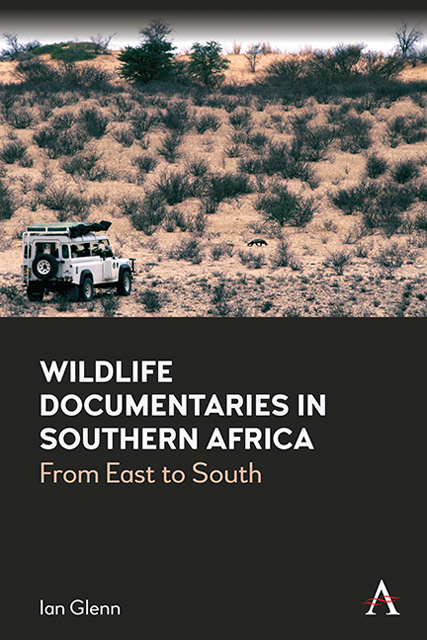Book contents
- Frontmatter
- Dedication
- Contents
- List of Figures
- Acknowledgements
- Introduction
- Chapter 1 What do the Critics Say?
- Chapter 2 A Theoretical Coalition?
- Chapter 3 Gone South: From East to Southern Africa
- Chapter 4 Private Lodges, Infrastructures and Guides
- Chapter 5 Going South: The Results
- Chapter 6 The Early History
- Chapter 7 The South Africans Enter the Game
- Chapter 8 Michael Rosenberg and Partridge Films
- Chapter 9 David and Carol Hughes
- Chapter 10 The Bartletts in the Namib, the Liversedges in Botswana
- Chapter 11 John Varty, Elmon Mhlongo and Londolozi
- Chapter 12 Richard Goss and Kim Wolhuter
- Chapter 13 Dereck and Beverly Joubert
- Chapter 14 Other Major Contributors
- Chapter 15 Going Live: Africam And Wildearth
- Chapter 16 Craig and Damon Foster
- Chapter 17 Must Love Animals?
- Chapter 18 The Social Turn
- Chapter 19 The Future of the Genre
- Chapter 20 The Influence of the Genre
- Conclusion
- Filmography
- Plates
- References
- Index
Chapter 6 - The Early History
Published online by Cambridge University Press: 10 January 2023
- Frontmatter
- Dedication
- Contents
- List of Figures
- Acknowledgements
- Introduction
- Chapter 1 What do the Critics Say?
- Chapter 2 A Theoretical Coalition?
- Chapter 3 Gone South: From East to Southern Africa
- Chapter 4 Private Lodges, Infrastructures and Guides
- Chapter 5 Going South: The Results
- Chapter 6 The Early History
- Chapter 7 The South Africans Enter the Game
- Chapter 8 Michael Rosenberg and Partridge Films
- Chapter 9 David and Carol Hughes
- Chapter 10 The Bartletts in the Namib, the Liversedges in Botswana
- Chapter 11 John Varty, Elmon Mhlongo and Londolozi
- Chapter 12 Richard Goss and Kim Wolhuter
- Chapter 13 Dereck and Beverly Joubert
- Chapter 14 Other Major Contributors
- Chapter 15 Going Live: Africam And Wildearth
- Chapter 16 Craig and Damon Foster
- Chapter 17 Must Love Animals?
- Chapter 18 The Social Turn
- Chapter 19 The Future of the Genre
- Chapter 20 The Influence of the Genre
- Conclusion
- Filmography
- Plates
- References
- Index
Summary
Introduction
Why did South Africa and the Kruger National Park (KNP) in particular not become a major early locus for African wildlife filmmaking? Why was the most visited and best-known African wildlife reserve, the place which probably drew more tourists than the rest of the continent’s wildlife reserves combined, not the continent’s first and most prominent locale for wildlife filming?
A first obvious point is that the KNP is in many ways a difficult place to see animals and to film them – at least compared to the savannahs of East Africa, or the waterholes of Etosha. The road network for tourists covers only a small part of the total surface of the park and limits access to most of the park. Trees block views and animals can disappear easily. For most of this period, almost all of the park was closed for the summer months because of dangers of contracting malaria. Anybody filming animals is likely to be disturbed by other tourists viewing or vying for good viewing spots. The Kruger Park also has obvious signs of human shaping: roads, rest-camps, telephone wires and fences. These too may have discouraged filmmakers looking to create an illusion of an untouched wilderness.
A neat example of the problems filmmakers faced and the ways they tried to liven up footage could be found in a French television news item aired on the 1 July 1954, with the title ‘Sans Barreaux’ or without bars. In this insert, reporter Jean Hudelot is shown entering the park at an entrance gate. Animals are photographed from the car window. A sleeping lion is roused by the reporter banging on the car to wake him up. Inserted in this is a sequence of the intrepid reporter hiding behind some bushes to view the game and then moving fast back to his car. One scrupulous editor somewhere annotated the sequence: some scenes were shot in the Bois du Boulogne! Clearly a series of shots of a rather portly reporter in a car and animals rather more distant than they would be in a zoo were not felt to be entertaining enough, and the journalist or editor in Paris decided to add drama by having the reporter out of the car.
- Type
- Chapter
- Information
- Wildlife Documentaries in Southern AfricaFrom East to South, pp. 71 - 90Publisher: Anthem PressPrint publication year: 2022



